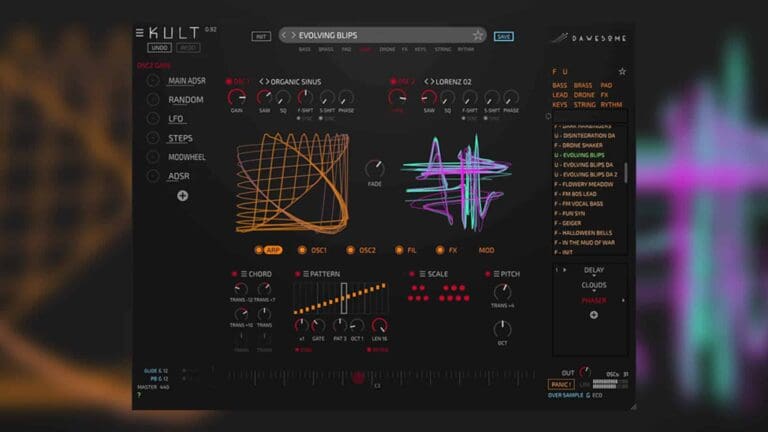Sometimes the wheel does need to be reinvented, or at least reimagined. Surely the world we live in today would not be the same if we called it a day on a rudimentary stone circle. The same absolutely applies to music, and by association, synthesis. In a music production world of endless synthesizers, sometimes a little reinventing, or reimagining, freshens up the sonic landscape for both the creator and listener. Kult by Dawesome is one that does synthesis in an interesting and addictive way, without straying too far from the function and process, and keeps the inspiration wheels turning.
Note: Kult is available for both Mac and PC and can be purchased or demoed for free under a 90-day trial through Plugin Boutique.
As a continuation of Kult from our previous article on 2 new and exciting synths to check out in 2023, we’re going to take a deeper dive into the groundbreaking synthesis of Kult. Kult offers a wide range of synthesis possibilities through its many incredibly immersive and interactive features, but for simplicities sake, I’ve zeroed in on some key features. These features include:
- Oscillators – “Strange Attractors”
- Oscillators – Voicing Window
- Arp
- Filter
- FX – Chorus, Delay, Phaser, Reverbs
- Modulators – ADSR, Mod Wheel, Random, LFO, and more
- Output Window
- Kult’s Presets
Oscillators – “Strange Attractors”

As with every synth, we must first get acquainted with that which produces the foundational sound- the oscillators. Many synths come with the usual basic wave shapes, some analog and digital hardware emulations, and maybe a few that are custom complex shapes. While Kult does come with a couple of variations on the classic outfit of basic shapes, it goes off the rails into chaos theory with its star of the show, the many wavetables designed from the mathematical theory known as “Strange Attractors.”
30 in total, these wavetable sculptures deliver a refreshing, organic, and charismatic sonic landscape; without any processing at all, these wavetables seem to have a dynamic emotionality. Whether a sound designer is thinking of designing a warm pad, a brutal bass, or a massive frigid atmosphere, the wavetables come with the range. Focusing on the sonic quality, the unique harmonic relationships that make up the wavetables lend to the organic and believable sound. Believability can sometimes make or break a synthesis tool, but the harmonics approach taken for designing the wavetables for Kult is so unique and well thought out, that it just works.
Directly below each wavetable selector are a few knobs: gain, saw, square, f-shift, s-shift, and phase. Gain being self-explanatory, the saw and square parameters essentially inject their associated basic wave shape harmonic relationships into the chosen wavetable, This is great for getting certain basic timbres blended in for tonal simplicity and relatability, or even, as an example, low-end thickness from a saw in an otherwise hollow tone. F-shift and s-shift are a frequency shifter, and an LFO on the wavetable’s phase, respectively. Fascinating modulation options, with s-shift being unique to Kult. Phase is simply the phase of the wavetable.
Lastly, with the immediate view of oscillators, it’s hard to miss the vibrant and abstract shapes that appear with each wavetable. These shapes were designed with the “Strange Attractors” mathematical theory in mind, and create a visual representation of the sound coming out of the oscillator, and when it is modulated. For example, applying f-shift adds movement to the otherwise static visual, because it is being frequnecy shifted, and the harmonics are moving around in real time, sonically. Both f-shift and s-shift can be synced to the project tempo.
Oscillators – Voicing Window
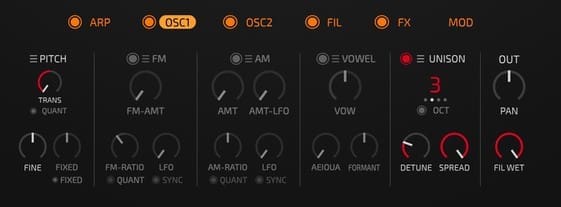
Once we have our oscillator tone decided, it’s time to head directly below the visual to the windows for oscillators 1 and 2 labeled OSC 1 and OSC 2, with OSC 2 positioned directly on the right of OSC 1. These windows are where designers can get more detailed in their synthesis with parameter sections for pitch, FM, AM, vowel, unison, and filter application amount. Albeit somewhat hidden at first glance, the location of these parameters makes for a clear and organized layout. Much different from the sometimes congested look of other tools.
Each section’s parameters are clearly labeled and easy to understand, regardless of skill level. Side note: in the bottom left corner is a question mark that turns green when enabled, and reads out the description of what each parameter is and can do. Pitch can be used to raise or lower the pitch of the sound by semitones with “Trans,” or by cents with “Fine.” Turning “Fixed” on will fix the oscillator to a specific note. “FM” is where designers can apply frequency modulation, “AM” for amplitude modulation, “Vowel” for injecting vocal quality formants, and “Unison” for added voices with a maximum of 5, and detune with or without spread. The unison in particular sounds expressive and unique.
Arp

Sidestepping to the left lands us on the arpeggiator function in Kult. More than just a traditional arpeggiator, this section includes parameters to set up chords, a traditional arp, and adjust the pitch and scale of the chord or arp pattern setups. Additionally cool, is the scale selector option comes with some exotic scales- a nice touch for exploring interesting harmonies. Exotic or classic, whichever scale is desired, the scale selector coupled with the chord designer can make for some interesting atmosphere designing sessions that won’t require multiple MIDI notes or piano theory for inputting notes. More creativity with simplicity unlocked.
Filter
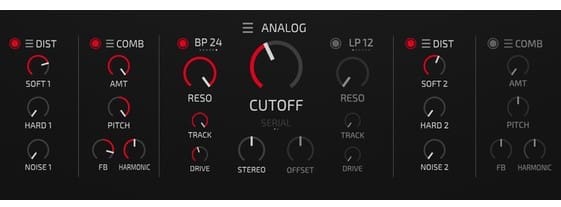
Farily limited but nevertheless high-quality and focused is Kult’s filter. Outwards to inwards, the filter section includes two distortion units, 2 combs, and two filters which can be set independently as low-pass, high-pass, or band-passes with 12 or 24dB/octave slopes. This filter cutoff section comes with the usual resonance and drive parameters but also features stereo and filter offset parameters for further synthesis weirdness. Each filter can also have amounts of key-tracking applied from 0-100.
While the filter section is limited, it makes up in its charismatic sonic print. The distortions sound absolutely high-quality and further pushing of them doesn’t lead to ear-piercing destruction. The same goes for the comb filters, which in recent times have become a fun tool to boost feedback and resonances for metallic and tonal qualities. In Kult, they sound playfully rounded.
FX – Chorus, Delay, Phaser, Reverbs
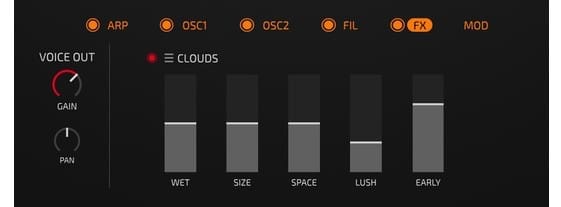
The continuation of creativity and inventiveness in Kult can be found in the FX section which features, on the surface, a limited collection of options. However, upon further discovery, two things become clear: 1. Kult does not need any more FX because 2. the included FX are first-rate and cleverly designed. From conventional to unconventional, the included FX are an EQ, chorus, phaser, delay, and different types of reverbs, and can be selected on the far right-hand window that when empty says “No FX, click plus to add FX.” When selected, the interfaces of the FX are cohesive and don’t change much; a nice touch for easy programming.
The EQ, chorus, phaser, and delay are the most conventional being that they are set up to do exactly as they are named without any fussing about. Nonetheless, they all sound great. The delay comes with the necessary ping-pong options as well. The unconventionality begins however with the reverbs which are named “reverb, clouds, and shimmer” from top to bottom in the menu. These naming choices are brilliant in that they follow the tonal implication of the kind of effect they have on the sound, as well as the aesthetic property. For example “clouds” is the perfect name for this reverb which adds a “sky above” dimension and space, while “shimmer” adds a bright springy reverb quality. Again, synthesis, redefined.
Modulators

Let’s now step into the backroom of Kult and take a look at its modulation feature and modulation types. Easily explained, modulation in Kult is set up by selecting the type of modulation you want, and applying it to one or many parameters of your choosing. Furthermore, multiple types of synthesis modulation can be applied such as pressure, slide, velocity, lift, glide, key-tracking, ADSR (envelope), LFO, steps, or my favorite, randomization. There’s something for everyone here. Whether you’re wanting a simple wobble from LFO modulation on the filter cutoff, or highly detailed modulation for MPE-esque cinematic sounds, there are nearly limitless synthesis possibilities.
Signal Output Features
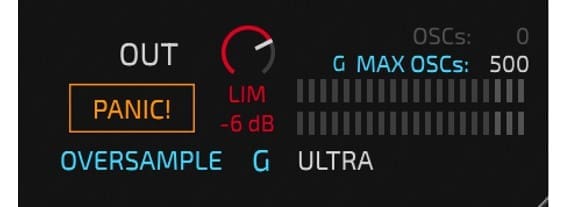
Our signal path now leads finally to Kult’s output features. Seemingly non-important, but all considered above, a few things under the hood here add to the quality of the overall sound, and can also save your ears, or mix, in a pinch. Simply defined, the output features come with a master output, oversampling options, which can be defined either globally or per patch, and my favorite a PANIC! button. Let’s focus on the latter two.
Oversampling is one of those somewhat noticeable functions in many digital synthesis applications, however in a deeply designed piece of kit such as Kult, having the option to get varying levels of fidelity can make a noticeable difference. Without getting too much in to the specifics oversampling, lower options reduce fidelity and CPU, while higher values increase fidelity, but with sacrificing CPU power. With as large a sonic synthesis palette as Kult offers, some sounds can sit comfortably at lower values, while those rich textures or cinematic scapes rely on a touch more digital subtlety.
Lastly, the PANIC! button is a fantastic feature that has not been overlooked. Highly experimental synthesis tools such as Kult can sometimes send your sound on a 90 degree upward trajectory of loudness or FX chaos; a button that immediately silences the sound can be a massive ear-saver. Furthermore, in a recording situation, audio tails can quickly and elusively muddy up a mix- a button on hand to keep background noise or dissonant harmonic tails can save uneccessary investigation time.
Kult’s Presets

All functions considered, one of the best ways to learn how they work in tandem or for specific kinds of effects, is to check out a synthesizer’s presets. Kult comes with a total of 314 professionally designed presets made up of basses, drones, lead synths, keys, pads, strings, FX, and rhythms. Many of the presets are immediately useable for a full mix.
Conclusion
Consider the synthesis wheel reinvented. Kult is a hidden gem of a synth that can be of huge benefit to music producers, sound designers, and artists of any skill level and style. While it is on the surface a more complex-looking machine, Kult is loads of fun to use and doesn’t take too much theoretical synthesis knowledge to get to grips with. Since the sonic quality is first-rate, and the wavetables are unique, great results can easily be found. The charisma, dynamic range of synthesis, and intriguing science behind the synth all make Kult by Dawesome a definitive, one of a kind iconoclast in sound synthesis.
Now I turn to you- which new synths are you checking out? If you’re curious for more, we’ve also listed our top 3 free and paid synths in the previous article.
Thanks so much for reading.
About The Author

Name: Imaginate
Bio: Imaginate is a renowned American recording artist and award-winning sound designer known for his unique, eclectic blend of music. In 2019, he began releasing a series of award-winning collections, including Glitch Kitchen and Kaleidoscope Neuro DNB on Loopmasters and Aqua, Charta, Verre, Terra, Metallum, and Aer as part of the Elements Series with Black Octopus Sound, and released on Splice. He has also released numerous synth presets and sample packs with Slate Digital. Imaginate is also a songwriter, composer, and performer of original music which you can listen to here.
